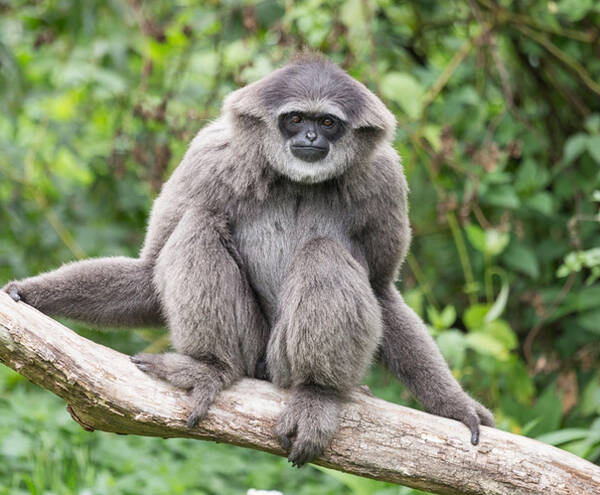Hylobates moloch
IUCN
LCBasic Information
Scientific classification
- name:Hylobates moloch
- Scientific Name:Hylobates moloch,Silvery Javan Gibbon
- Outline:Primates
- Family:G.family genus
Vital signs
- length:45-64cm
- Weight:5-9.6kg
- lifetime:25-44years
Feature
The body is silver-gray, with a white ring around the eyebrows and cheeks
Distribution and Habitat
Distributed in western Java, Indonesia.
It lives mainly in tropical rain forests in South and Southeast Asia, active in the upper canopy of semi-deciduous monsoon forests and tropical evergreen forests. It is also found in the upper canopy of lowland and mountain forests. It spends most of its life in trees and rarely descends to the forest floor. It lives at an altitude of 1,600 meters above sea level, sometimes as high as 2,000-2,400 meters.
Appearance
The average weight of the silvery gibbon is 8 kg, and the head and body length is 45-64 cm. Males weigh 5.3-9.6 kg, and females weigh 5-7 kg. The body hair is dense, the crown is dark gray, and the body is silver-gray. A white ring is formed around the eyebrows and cheeks, clearly outlining the black hairless face. There is no obvious gender difference between the two sexes in terms of body size or fur color. The legs are short, the palms are longer than the soles, and the finger joints are long; the body is slender, the shoulders are wide and the hips are narrow; there are long canine teeth. There are calluses on the hips, no tail and cheek pouches. There is a large sound pouch in the throat.
The silvery gibbon has a slender body and a pair of long arms, which are essential for their survival and facilitate their flexible climbing and movement in the tropical rainforest.
Details
Silvery Javan Gibbon (scientific name: Hylobates moloch) is called Silvery Javan Gibbon in English. There are 2 subspecies.

Silvery Javan Gibbon usually gathers in small groups of families, usually 4. Among them, there is an adult male and an adult female, and the rest are semi-adult and young gibbons, with an adult male serving as the leader. Gibbons have a relatively long maturity period, and their family relationships are not only stable, but also harmonious and friendly. Family members are generally very harmonious, caring for each other and defending each other.
The silvery gibbon is a typical arboreal animal. Its habits are similar to those of other gibbons, and it lives a male-female mating family life. It is territorial, and the territory of each group is about 20 to 35 hectares, but it only forages within 10 hectares a day. During the day, it usually climbs branches with its arms at least 10 meters high in the forest, swings and leaps, uses both its front and rear limbs, and is as fast as flying. The moment it leaves between two trees, it seems to be flying in the air. Due to the high characteristics of this movement, the chest and arms often change direction. Long-term evolutionary adaptation has made the shoulders flatter on both sides, instead of being wider like monkeys. The elbows are longer and can rotate 360 degrees in all directions. They can move forward and backward quickly, and their feet only play the role of assisting pedaling. They can move on two feet for a short distance on the ground. The average distance moved per day is 1514 meters. They have keen hearing and smell, are timid and afraid of cold. They are arboreal species and sleep in trees at night. They are active for up to 10 hours a day.
Tactile communication between family members of the silvery gibbon is very important. Tactile communication involves grooming, mating, playing, and sometimes aggressive behavior. In addition to vocal and tactile communication, these animals also use facial expressions, gestures and body postures to communicate with their own species.
Silvery gibbons are well-known apes with loud calls, which they use to communicate. Females often have a slow rise and fall, interrupted by vibrato, which is the most distinctive call. The male's call is sandwiched between the female's voice. The call of the male silvery gibbon is usually to declare territory and intimidate neighbors, which is to defend their territory or as a means of maintaining social organization. Studies have shown that males and females can be identified by their calls, and each animal has its own unique voice. Calling is the main way for group members to communicate. Every morning, males and females cry like a chorus, or ups and downs, or sad and low, or make a WOW..WOW... sound. The male also adds a tail sound at the end of the call.

Silvery gibbons consume large amounts of fruit. Like other gibbons, these animals primarily eat fruit, but also eat leaves, insects, flowers, young stems, buds, and seeds.
A pair of silvery gibbons can give birth to 5-6 litters in their lifetime, with a 40-month interval between births. There is no strict breeding season. The gestation period of females is about 7-8 months. After mating and conception, they still move with the group. After 3-4 months, their abdomens bulge slightly. As the fetus grows, their abdomens gradually increase, and their daily actions become more cautious, but they still stay with the group until delivery. Delivery usually occurs in autumn and early winter, with an average gestation period of 243 days. Each litter only produces one baby, and the weaning period is up to 24 months. The offspring stay in the parent group where they were born. When they are 6-7 years old and sexually mature, they will leave the original group to find a mate. The lifespan is about 25 years. It can reach 44 years in captivity.
Silvery gibbons are only distributed on the island of Java in Indonesia; there are 300-400 of them; they hang cautiously on the tiny land of Java National Park, one of the most densely populated islands in the world. It has been protected by law throughout Indonesia since 1924. There are 15 regions distributed, and the largest group is in the national park. In 2003, there were 56 silvery gibbons living in Indonesian zoos, 15 living in four Indonesian wildlife rescue centers, of which five were in breeding condition. There is no evidence that the species has successfully bred in captivity in Indonesia. Outside Indonesia, 48 live in 10 institutions in nine countries, with six breeding pairs. As of 2006, the total ex-situ population is approximately 120 individuals, most of which are wild. Their habitat is rapidly declining due to large-scale logging. Habitat loss is the main threat to the gibbon species due to logging and agricultural needs.
Listed in the 2008 IUCN Red List of Threatened Species ver 3.1 - Endangered (EN).
Listed in the CITES Appendix I protected animals of the Washington Convention.
Protect wild animals and eliminate game.
Maintaining ecological balance is everyone's responsibility!








